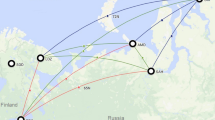Abstract
We present the results of numerical simulations of ionospheric parameters, which permit one to explain the occurrence of additional features in the ionograms obtained in the experiment onboard the “Mir” space station. During this experiment, the station flew below the electron-density maximum of the ionospheric F2 layer. It is shown that the “lower” traces of the ionograms can be evidence of the presence of a horizontal gradient in the ionospheric parameters.
Similar content being viewed by others

REFERENCES
N. P. Danilkin and A. Ivanov, Novosti Kosmonavt. No. 8, 56 (1999).
N. P. Danilkin, Int. J. Geomagn. Aeron., 2, No. 3, 173 (2001).
N. P. Danilkin and N. G. Kotonaeva, Radiophys. Quantum Electron., 45, No. 5, 335 (2002).
N. P. Danilkin and O. A. Mal'tseva, Ionospheric Radio Waves: Theory, Algoritms, and Codes [in Russian], RGU Press (1976).
Author information
Authors and Affiliations
Rights and permissions
About this article
Cite this article
Danilkin, N.P., Kotonaeva, N.G. The Features of Ionospheric Radio Sounding Performed using the “Mir” Space Station. Radiophysics and Quantum Electronics 45, 431–439 (2002). https://doi.org/10.1023/A:1019960500782
Issue Date:
DOI: https://doi.org/10.1023/A:1019960500782



